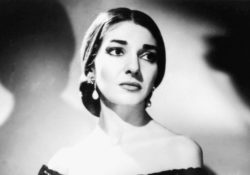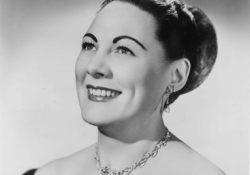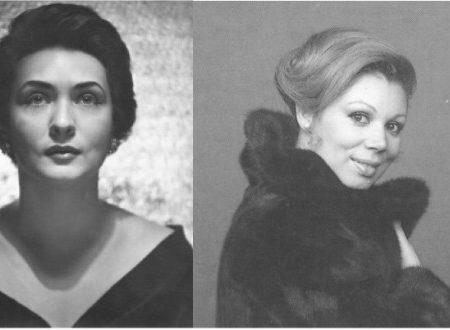Introduction
Photo above: Maria Callas from the television talk show Small World. The program was hosted by Edward R. Murrow.
COMMEMORATING MARIA CALLAS AT THE CENTENARY OF HER BIRTH
Maria Callas was born 100 years ago on the 2nd of December 1923. Her meteoric career was short, as was her life, as she passed away on the 16th of September 1977 at just 53 years old. To commemorate her art and the tremendous influence she exerted on the operatic world, the internationally acclaimed opera scholar Roger Pines and the internationally extolled baritone and pedagogue Thomas Hampson discuss her legacy, with recordings spanning much of her career. There are also archive recordings of recollections from people who knew and worked with her.
The feature is produced by Jon Tolansky.
MARIA CALLAS CENTENARY COMMEMORATION RECORDINGS
1949, live, Naples
The advent of a true dramatic coloratura soprano – the voice that flabbergasted Italian audiences.
“Ben io t’invenni”
2) I PURITANI – BELLINI
1949, studio recording
What a contrast – it was unheard of at the time to have same singer able to excel as both Abigaille and Bellini’s Elvira!
This recording reminds us of her 1949 triumph in Venice, when she learned Elvira in a couple of days while performing as the Walküre Brünnhilde during the same week.
“Vien, diletto”
3) TRISTAN UND ISOLDE – WAGNER
Again, the contrast here: She had already sung Isolde in 1947 and 1948. This Liebestod is from her first recorded operatic recital in 1949.
“Mild und leise” (Liebestod) – sung in Italian as “Dolce e calmo.”
1952, live, Florence
Memorable evidence of her brilliance in lighter, more filigree-like coloratura.
“D’amore al dolce impero”
1952, live, Milan
This shows her exceptional qualities in heavy dramatic-coloratura material.
“Vieni, t’affretta”
6) LUCIA DI LAMMERMOOR – DONIZETTI
1952, live, Rome
Evidence of a sound she brought to the role that was radically different from her predecessors.
“Ardon gl’incensi”
1953, Milan, with Leonard Bernstein conducting
Callas was supreme in her line-by-line response to the text and her understanding of Cherubini’s elusive style, especially in her performances with Bernstein at La Scala.
Recitative preceding “De’ tuoi figli”
8) NORMA – BELLINI
1954, studio recording
Norma’s entrance aria shows how Callas raised the standard for this role, and the inherent nobility and elegance in her command of the Bellini’s flowing vocal line.
“Casta diva”
9) UN BALLO IN MASCHERA – VERDI
1957, live, Milan
This performance from La Scala proves that, even post-weight-loss, she could on occasion still be comfortable in Verdi spinto repertoire.
“Teco io sto” (with Giuseppe di Stefano)
10) ANNA BOLENA – DONIZETTI
Live recording, 1957
Remembering one of her greatest triumphs at La Scala – an opera we probably wouldn’t know today had it not been revived especially for her.
“Coppia iniqua”
12) THE ABDUCTION FROM THE SERAGLIO – MOZART
1957, live rehearsal recording, Dallas
Konstanze’s aria shows that, even at this stage, Callas could still lighten her voice effectively and achieve pinpoint control in trills, very challenging coloratura, and extremes of range.
“Martern aller Arten” (sung in Italian as “Tutte le torture”)
13) LA TRAVIATA – VERDI
1958, live, London
Her voice is becoming more and more fragile, but her musicality and dramatic involvement remain as impressive than ever in this Covent Garden performance. The vulnerability of the voice even enhances her identification with Verdi’s Violetta.
“È strano!…Ah, fors’è lui…Sempre libera”
14) POLIUTO – DONIZETTI
1960, live, Milan
Donizetti’s rarely heard Poliuto marked Callas’s return to La Scala after three years absence. Singing under extraordinary pressure, and even with real vulnerability in the upper register, she is still a master of style and has found a new and affecting femininity in her delivery.
“Di quai soave lagrime”
15) SAMSON ET DALILA – SAINT-SAËNS
1961, studio recording
Remembering her exploration of mezzo repertoire, in concert and on disc.
“Printemps qui commence”
16) TOSCA – PUCCINI
1964, live, London
The voice has become noticeably narrower and leaner, with the aria’s climax sounding fairly precarious, but the commitment to character remains complete. When Callas repeated Covent Garden’s production of Tosca in 1965, it would be her last appearance onstage.
“Vissi d’arte”
Notes and synopses written by Roger Pines
Puccini, NABUCCO, “Ben io t’invenni”
Abigaille has grown up in the palace of the Babylonian king, Nabucco, and believes herself to be his daughter. Nabucco has left the city to lead his army in battle, with his daughter appointed as regent. In his absence, Abigaille discovers a document revealing that her real parents, in fact, were slaves. In her intensely dramatic recitative, she looks forward to taking power and bringing about the downfall of both Nabucco and Fenena.
Bellini, I PURITANI, “Vien, diletto”
In 17th-century Plymouth, Elvira’s father, Giorgio, is in command of the Puritans’ fortress. His daughter, Elvira, is ecstatic that he has yielded to her wish to marryArturo, a Royalist. On her wedding day, Elvira is stunned to see Arturo escorting a veiled lady from the fortress. Elvira has no idea that the woman is Queen Enrichetta, widow of King Charles. Suspecting that Arturo has been unfaithful to her, Elvira goes mad. In the presence of her deeply concerned uncle, Giorgio, and another Puritan partisan, Riccardo (who is unrequitedly in love with Elvira), Elvira distractedly thinks of the absent Arturo and longs for him to return to her.
Wagner, TRISTAN UND ISOLDE, "Mild und leise” (Liebestod) – sung in Italian as “Dolce e calmo”
Morold, betrothed to the Irish princess Isolde, has been killed by Tristan, nephew of the aged King Marke of Cornwall. Tristan is ordered by Marke to escort Isolde to Cornwall, where she is to marry the king. On board ship, Isolde plans to use a fatal potion to kill both herself and Tristan, but Brangäne, her maid, substitutes a love potion. At night in Cornwall, Tristan comes to Isolde while her husband is off hunting. The lovers are discovered, leaving Marke deeply shocked and saddened. Tristan is mortally wounded by Melot, the king’s henchman and his own former best friend. Brought to his ancestral home, Tristan lies in delirium, longing for Isolde. When her ship finally arrives, he has only a moment to utter her name before dying. Isolde falls in a faint over his body. Another ship arrives, carrying Marke and his men. Melot is killed by Tristan’s devoted servant, Kurwenal, who is killed by Marke’s soldiers. Suddenly reviving, Isolde sings her “Love-Death,” in which she feels an unearthly ecstasy and imagines Tristan returning to life.With her final words, “highest bliss,” Isolde dies.
Rossini, ARMIDA, “D’amore al dolce impero”
In her meeting with Goffredo, captain of the Crusaders, the sorceress Armida claims to be a noblewoman whose reign as ruler of Damascus has been thwarted. Goffredo remains unaware of her true identity, and that she is the ally of Idraote, her dastardly uncle. So enraptured are Goffredo and his men by Armida that they decide to assist her. The heroic Rinaldo is chosen as commander of ten soldiers to protect Armida. No one knows that she had encountered Rinaldo previously and had fallen in love with him. After killing the violently jealous Gernando in a duel, Rinaldo manages to escape with Armida, who brings him to a mysterious forest. She transforms it into a magnificent palace, where – in a spectacular aria (written in theme-and-variations style) – she declares that no living creature can resist the sweetness of love, which commands every heart.
Verdi, MACBETH, “Vieni, t’affretta”
Macbeth, Thane of Glamis, encounters a group of witches, who predict that he will soon be named Thane of Cawdor and then King of Scotland. Subsequently, Macbeth is stunned when the first prophecy is fulfilled. He describes these events in a letter to his wife. After reading the letter, the obsessively ambitious Lady Macbeth sings a formidably demanding aria, expressing her passionate longing for him to embrace the witches’ prophecies so that he may soon ascend to the throne.
Donizetti, LUCIA DI LAMMERMOOR, “Ardon gl’incensi”
Forced into a loveless marriage, Lucia is rejected and cursed by her brother’s enemy, Edgardo, the man she truly loves. On her wedding night, Lucia goes mad and murders her bridegroom. The wedding guests, still celebrating, are shocked by the sudden appearance of Lucia. In her celebrated “Mad Scene,” she imagines herself married to her beloved Edgardo and murmurs, “At last I’m yours, at last you’re mine.”
Cherubini, MEDEA, “Taci, Giason, e affissi immoto il suolo?”
The sorceress Medea is the mother of the hero Jason’s two children. Jason, however, is betrothed to Princess Glauce, daughter of Creon, King of Corinth. Medea travels to Corinth to find Jason. When finally alone with him, she castigates him for his cruelty to her, while also recalling the day he first saw her, the joy of their love, and how important she had once been to him.
Bellini, NORMA, “Casta diva”
Deep in a forest in Gaul, the Druids gather and welcome the appearance of Norma, their high priestess. Her father, Oroveso, speaks for everyone in insisting to Norma that they must delay no longer in avenging themselves against the oppression of Rome. Norma, however, informs them that the moment of vengeance has not yet arrived. They must bide their time and remain confident that Roman domination will eventually end. Meanwhile, the Druids should adopt a peaceful stance. In one of Bellini’s most glorious arias, Norma undertakes the sacred rite of cutting the mistletoe and intones a prayer, asking the goddess of the moon to calm the Druids’ hearts and bring peace everywhere.
Verdi, UN BALLO IN MASCHERA, “Ebben, sì, t’amo!”
Renato, secretary and best friend of Sweden’s King Gustavo, is also the husband of Amelia. Her feelings for the King lead Amelia to visit a fortuneteller, Ulrica, who believes Amelia can rid herself of this guilty passion by finding a magic herb in a wild place on the outskirts of the city. Amelia goes there at midnight, but she’s surprised by the appearance of Gustavo. He woos her and, after much hesitation, she finally yields. The two express their love in a magnificently exultant duet.
Donizetti, ANNA BOLENA, “Coppia iniqua”
Having fallen in love with Jane Seymour, King Henry VIII sees to it that his second wife, Anne Boleyn, is accused of high treason. Anne is sentenced to death and, with all in readiness for her execution, she thinks of Henry and Jane. In her hair-raising final aria, she reveals that, rather than cursing them, she will forgive them from the grave. She hopes that God, in His compassion, will look kindly on her and offer her mercy.
Mozart, DIE ENTFÜHRUNG AUS DEM SERAIL, “Martern aller Arten” (sung in Italian as “Tutte le torture”)
The noble Konstanze, betrothed to Belmonte, is captured and taken into the harem of Pasha Selim. Each time the Pasha demands that Konstanze love him, she refuses. He finally gives her an ultimatum: if she again refuses, rather than having her executed, he will subject her to every torture.In her musically and vocally stupendous aria, Konstanze insists that nothing he can do will shake her fidelity to the man she loves.
Verdi, LA TRAVIATA, “Ah! fors’è lui"...Sempre libera”
In Paris, the beautiful but fragile Violetta Valéry is a celebrated courtesan. During a party at her home, she encounters Alfredo Germont, who has loved her from afar. Violetta’s guests move into the next room for dancing, but she feels faint and stays behind. Alfredo’s concern for her leads him to remain with her. He declares his love, but she laughs him off, but his words leave a deep impression on her. After the party, Violetta -- in the first of the role’s three arias -- reflects on whether Alfredo could indeed be the true love that she never thought would be hers.
Verdi, LA TRAVIATA, "Sempre libera”
After thinking that she might find true love in Alfredo Germont, the courtesan Violetta Valéry abandons that idea and proclaims that she will continue to live a life of pleasure until her dying day. She expresses that desire in a gloriously exhilarating aria that demands the ultimate in technical prowess.
Donizetti, POLIUTO, “Di quai soave lagrime”
Christianity has been banned in Rome, and any Christian, if discovered, will be executed. Nevertheless, Poliuto, who has converted to Christianity, courts danger by coming to a cave where a group of Christians has secretly gathered to be baptized. He has no idea that his wife, Paolina, has followed him there, having suspected that her husband has become a Christian. She hears voices coming from the cave andsuddenly feels unexpectedly moved by them, a feeling she expresses in in a beautiful, deeply touching aria.
Saint-Saëns, SAMSON ET DALILA, “Printemps qui commence”
The Philistines wish to defeat Samson, the Israelites’ greatest hero, by finding the secret of his awe-inspiring strength. The Philistines’ ally is Dalila, priestess of the god Dagon, who hopes to have Samson visit her at her home in the valley of Sorek. Emerging from the temple of Dagon, Dalila performs an alluring dance before Samson. She then sings an exquisitely beautiful aria, in which she lets him know that spring is coming and that it brings hope to those in love.
Puccini, TOSCA, “Vissi d’arte”
Baron Scarpia, chief of the Roman police, has ordered that his enemy, the revolutionary Mario Cavaradossi, be executed by firing squad at dawn. Scarpia lusts after the singer, Floria Tosca, Cavaradossi’s lover, who is desperate to save Mario’s life.She confronts Scarpia, who remains implacable.Turning to God, Tosca asks why -- after dedicating her life to art and love, while also remaining a woman of sincere faith – He should choose to repay her this way.


